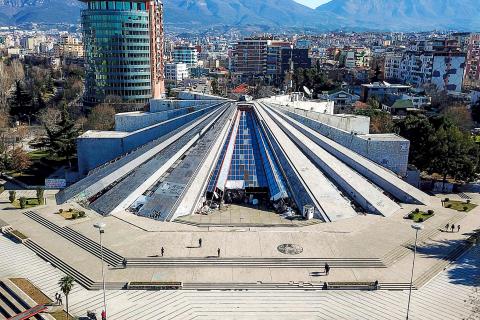The sprawling, space-age “pyramid” in Tirana’s center had many uses before falling into ruin: Built as a museum for a dictator, it later hosted a NATO base, TV studio, nightclub and more.
After years of neglect, the crumbling structure is now set for another rebirth as an information technology hub in the heart of Albania’s fast-changing capital.
“I don’t think there is anyone who thinks it is beautiful, but it’s a sort of a landmark of the city and people want to preserve them in a city that has lost a lot” to development, said Joni Baboci, a city hall architect involved with the redesign.

Photo: AFP
The 11,400m2 behemoth has triangular wedges of graffiti-covered marble and dark window panes that meet at a peak, giving it the pyramid look.
For the project’s architects, its overhaul is about striking a balance between preserving and reclaiming a relic from a dark period of Albanian history.
The bizarre building was erected 30 years ago to glorify the life of then-dictator Enver Hoxha, who ruthlessly ruled Albania for four decades until his death in 1985.
After communism collapsed a few years later, the museum was shuttered and the pyramid became a venue for a merry-go-round of uses, reflecting the explosion of culture in a nation that had been hermetically sealed under Hoxha’s iron grip.
However, for the past 10 years the building has sat virtually abandoned, aside from the locals and tourists who can be seen scaling its walls for the 360° city view at the top.
When authorities announced plans to demolish the pyramid several years ago, protests broke out, revealing how the unusual monument had won its way into people’s hearts.
The demolition plan was scrapped and city hall came back last year with a project to turn the pyramid into a digital learning center.
“We thought there couldn’t be a better symbol than giving the building back to Albanian society in its best form, to the kids, for their future education,” said Martin Mata, of the Albanian-American Development Foundation, which is funding the more than US$10 million renovation.
It is a fitting purpose for a nation suffering from high youth unemployment and emigration rates.
Designs revealed last month by Dutch firm MVRDV open the structure on all sides of the ground floor, bring light into the atrium with more glass, surround it with trees and carve stairs onto its exterior to make the pyramid walls a safer climb.
“The pyramid will be open to everyone” and the building will be nearly “transparent,” chief architect Winy Maas said at a presentation in Tirana.
Inside will be a mix of commercial space and a learning center for young people, run by non-profit group Tumo, offering classes in computer programming, design and other digital skills.
For Tirana Mayor Erion Veliaj the project is a “story of resurrection” — for the pyramid and Albania itself.
“Since the fall of the Berlin Wall and the start of [Albania’s] transition, the question has been how do we make Albania great again?” he said.
The pyramid’s renovation is part of a dizzying amount of transformation that the nation’s capital has undergone.
The collapse of communism unleashed a massive wave of migration from rural areas to the capital, leading to unchecked construction, an explosion of vehicles and chaotic urban spaces.
As mayor of Tirana in the early 2000s, Albanian Prime Minister Edi Rama gave the city a major facelift by splashing its drab communist buildings with bright colors and bold patterns.
Veliaj says he is trying to further spruce up the city by cracking down on illegal construction, creating more parks and turning a massive Skanderbeg Square traffic roundabout into a pedestrian space.
The changes are raising Tirana’s profile on the tourist map.
Its vibrant cafe scene now comes in for praise, as well as the unique hodgepodge of architecture, including Italian fascist buildings, Soviet-style tower blocks, Ottoman-era mosques and, of course, the pyramid, but not all of city hall’s revamps are popular.
There have been regular protests in the last year over plans to knock down homes and shops for a ring road.
In the city center, a crowd has been demonstrating daily against a government-backed project to bulldoze Tirana’s national theater, built in 1930, and replace it with a modern one.
As for the pyramid, some would have preferred to see it become an archeology museum or national library, among other things, but for Rama, the transformation of a “symbol of dictatorship” to a “symbol of each individual’s power in a new time” is an apt road map.
“I am happy that we have managed to solve a problem that has vexed us for 30 years now,” he said.

Kehinde Sanni spends his days smoothing out dents and repainting scratched bumpers in a modest autobody shop in Lagos. He has never left Nigeria, yet he speaks glowingly of Burkina Faso military leader Ibrahim Traore. “Nigeria needs someone like Ibrahim Traore of Burkina Faso. He is doing well for his country,” Sanni said. His admiration is shaped by a steady stream of viral videos, memes and social media posts — many misleading or outright false — portraying Traore as a fearless reformer who defied Western powers and reclaimed his country’s dignity. The Burkinabe strongman swept into power following a coup in September 2022

‘FRAGMENTING’: British politics have for a long time been dominated by the Labor Party and the Tories, but polls suggest that Reform now poses a significant challenge Hard-right upstarts Reform UK snatched a parliamentary seat from British Prime Minister Keir Starmer’s Labor Party yesterday in local elections that dealt a blow to the UK’s two establishment parties. Reform, led by anti-immigrant firebrand Nigel Farage, won the by-election in Runcorn and Helsby in northwest England by just six votes, as it picked up gains in other localities, including one mayoralty. The group’s strong showing continues momentum it built up at last year’s general election and appears to confirm a trend that the UK is entering an era of multi-party politics. “For the movement, for the party it’s a very, very big

ENTERTAINMENT: Rio officials have a history of organizing massive concerts on Copacabana Beach, with Madonna’s show drawing about 1.6 million fans last year Lady Gaga on Saturday night gave a free concert in front of 2 million fans who poured onto Copacabana Beach in Rio de Janeiro for the biggest show of her career. “Tonight, we’re making history... Thank you for making history with me,” Lady Gaga told a screaming crowd. The Mother Monster, as she is known, started the show at about 10:10pm local time with her 2011 song Bloody Mary. Cries of joy rose from the tightly packed fans who sang and danced shoulder-to-shoulder on the vast stretch of sand. Concert organizers said 2.1 million people attended the show. Lady Gaga

SUPPORT: The Australian prime minister promised to back Kyiv against Russia’s invasion, saying: ‘That’s my government’s position. It was yesterday. It still is’ Left-leaning Australian Prime Minister Anthony Albanese yesterday basked in his landslide election win, promising a “disciplined, orderly” government to confront cost-of-living pain and tariff turmoil. People clapped as the 62-year-old and his fiancee, Jodie Haydon, who visited his old inner Sydney haunt, Cafe Italia, surrounded by a crowd of jostling photographers and journalists. Albanese’s Labor Party is on course to win at least 83 seats in the 150-member parliament, partial results showed. Opposition leader Peter Dutton’s conservative Liberal-National coalition had just 38 seats, and other parties 12. Another 17 seats were still in doubt. “We will be a disciplined, orderly